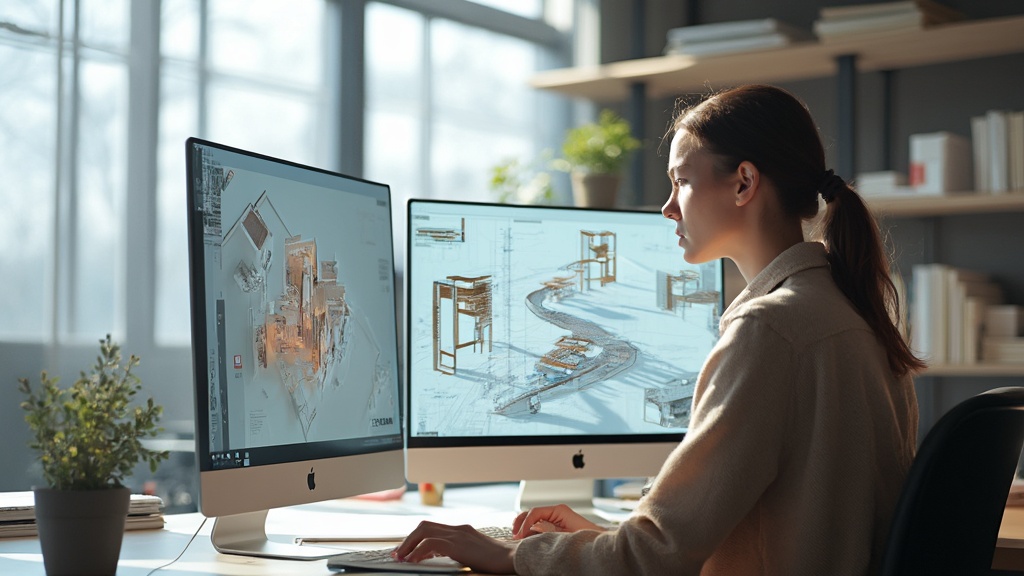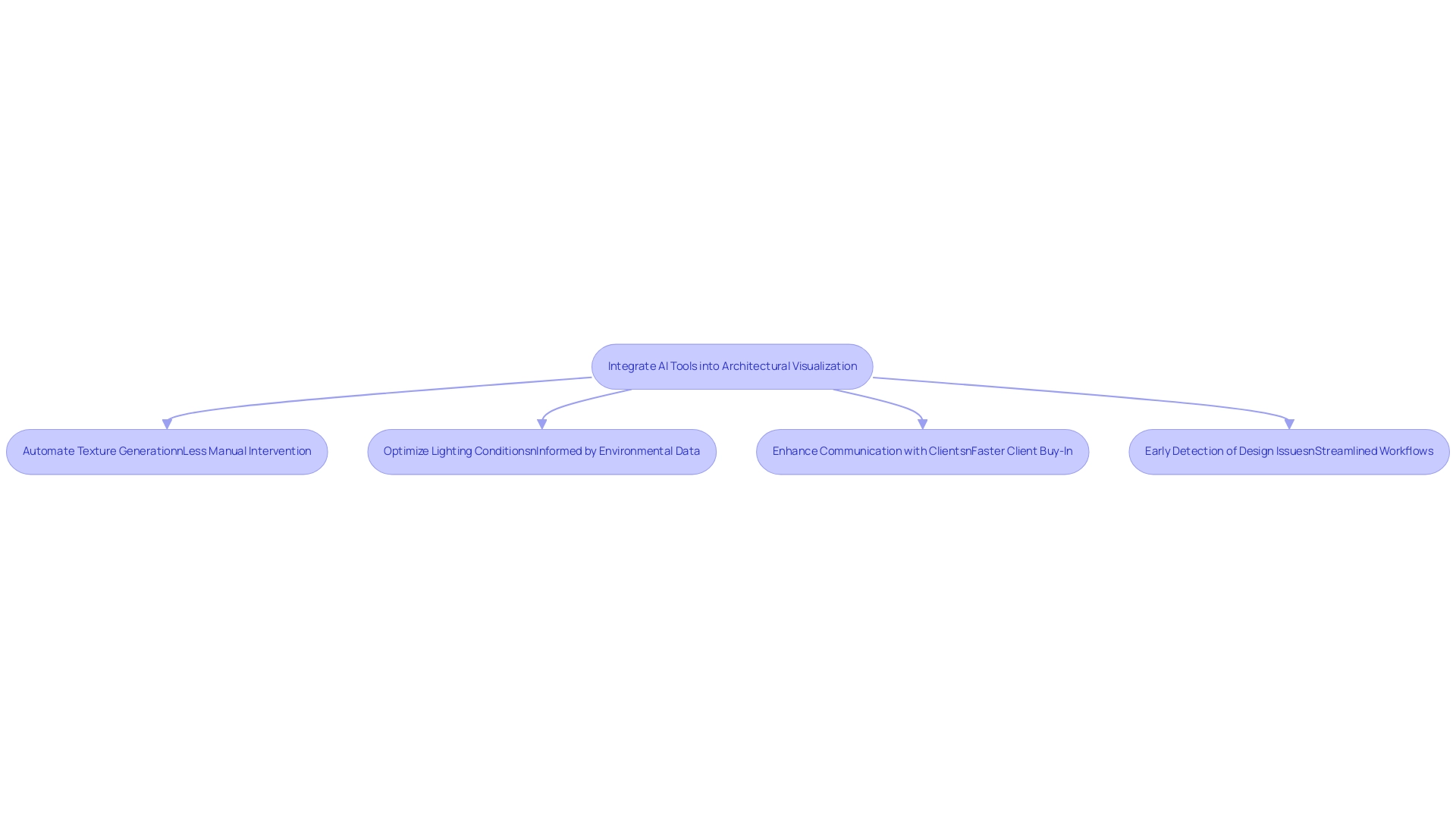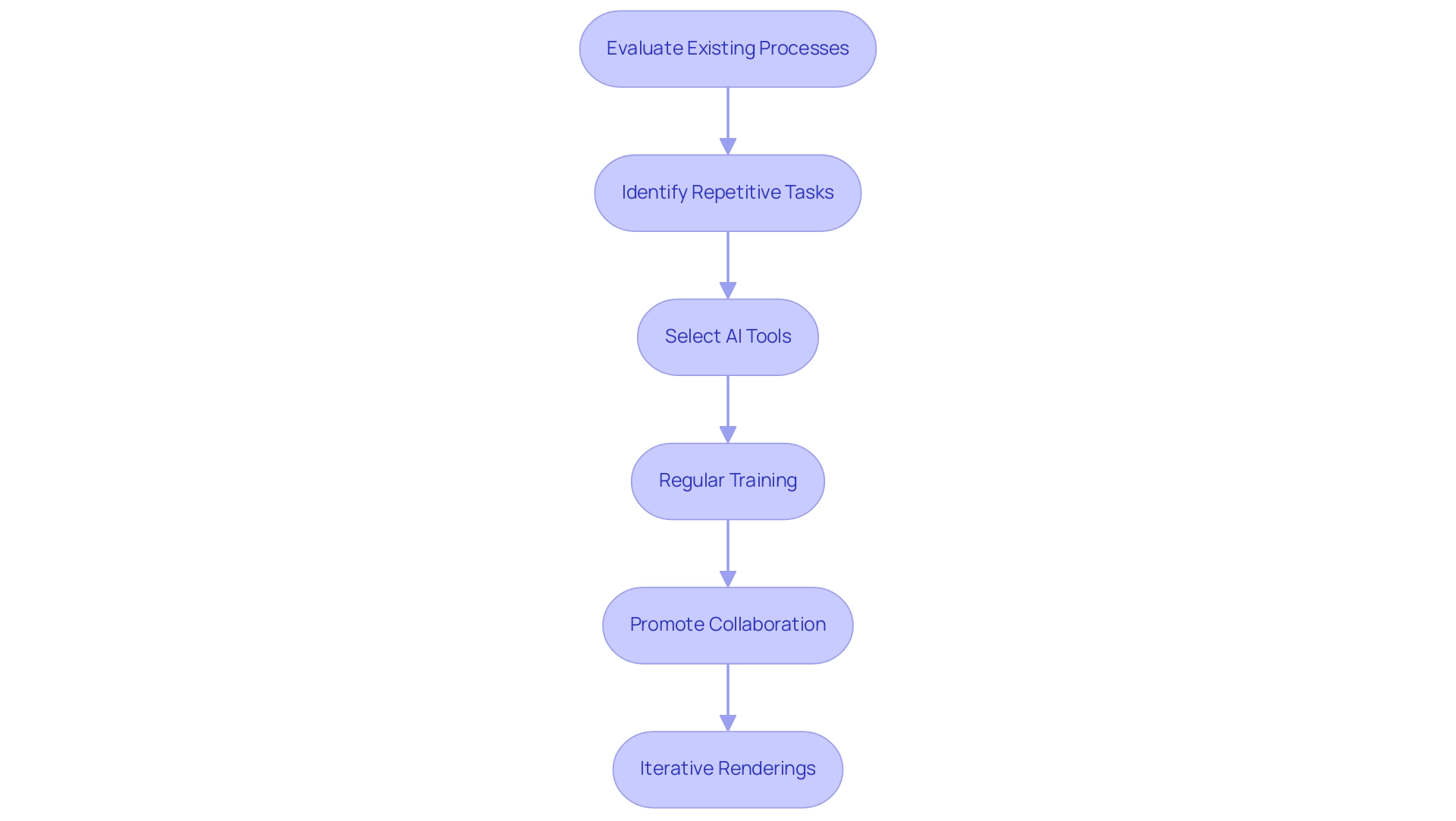Overview:
The best practices for utilizing AI in 3D architectural rendering involve automating repetitive tasks, selecting compatible software tools, and fostering collaboration between architects and AI specialists to enhance creativity and efficiency. The article supports this by illustrating how AI integration can significantly increase productivity, streamline workflows, and improve communication, ultimately leading to more innovative and contextually relevant visualizations that resonate with clients and stakeholders.
Introduction
In the evolving realm of architecture, the significance of 3D rendering techniques cannot be overstated. As architects strive to convey their design visions with precision and clarity, the integration of advanced rendering methodologies such as ray tracing and rasterization emerges as a cornerstone of effective communication.
These techniques not only enhance the visual representation of projects but also facilitate a deeper understanding among stakeholders, ultimately influencing decision-making processes. The advent of artificial intelligence further revolutionizes this landscape, streamlining workflows and enabling the creation of lifelike visualizations with unprecedented efficiency.
As the architectural rendering market experiences exponential growth, understanding the tools, trends, and best practices in this domain becomes essential for architects aiming to stay ahead of the curve and deliver compelling narratives that resonate with clients and investors alike.
Fundamentals of 3D Architectural Rendering Techniques
3D architectural visualization acts as a crucial procedure that converts digital models into lifelike images, greatly improving the communication of design ideas by designers. Two fundamental techniques at the forefront of this transformation are ray tracing and rasterization. Ray tracing meticulously simulates the behavior of light, yielding lifelike reflections and shadows that elevate the realism of materials within an image.
However, this technique often demands substantial computational resources, making it less suitable for real-time applications. Conversely, rasterization streamlines the conversion of 3D models into 2D images, typically offering faster processing times, which can be advantageous for immediate visual feedback. Proficiency in these visualization techniques is essential for architects, allowing them to select the approach that best fits the needs and expectations of clients.
Moreover, 3D townhome visualization empowers developers by providing clarity and certainty in a field where these qualities are highly coveted. Equipped with our visuals, developers craft an engaging story that not only markets homes but also future opportunities, improving communication with builders, lenders, and municipalities through detailed illustrations that clarify design intentions and timelines. As highlighted in the case study titled ‘Opportunities in 3D Visualization Market,’ the integration of the best AI in 3D architectural rendering along with machine learning technologies can automate processes, improve performance, and enhance image quality, leading to increased production efficiency across various sectors, including architecture.
The role of pre-sales visualization becomes increasingly significant, serving as a bridge between concept and reality, igniting interest and investment long before the physical realization of endeavors and generating crucial revenue for construction. Additionally, platforms such as OpenAsset are vital in overseeing digital assets and simplifying intricate tasks, offering architects important tools for their visualization processes. As the 3D visualization market surges, projected to grow from $4.59 billion in 2024 to $16.18 billion by 2032 with a CAGR of 17.0%, the significance of these techniques and tools cannot be overstated.
Contact us today to discover how our visualization services can bring your architectural visions to vibrant life and drive your projects forward.
Leveraging AI Tools for Enhanced Architectural Visualization
The integration of the best AI in 3D architectural rendering into architectural visualization represents a transformative leap in the rendering process, particularly through the application of neural rendering technologies. By utilizing advanced machine learning algorithms, tools in this category can produce high-quality images with considerably less manual intervention, allowing architects to shift their attention toward innovation instead of being hindered by technical nuances. AI-driven solutions not only automate the generation of realistic textures and optimize lighting conditions informed by environmental data, but they also facilitate enhanced communication among designers and clients, crucial for spotting and resolving design issues early.
This early detection streamlines workflows and minimizes costly changes later in the process, while also aiding in quicker buy-in from clients and investors. As architects adopt these cutting-edge tools, they can expect to see enhanced results from the best AI in 3D architectural rendering, which enables more dynamic and contextually appropriate visualizations that resonate with stakeholders. Additionally, the passion for capturing intricate details in architectural designs enhances realism and emotional impact, making projects feel lived-in and ready to be built.
Essential Software and Rendering Engines for 3D Visualization
Choosing the suitable software is essential for achieving the best AI in 3D architectural rendering to create outstanding 3D visuals in architecture. SketchUp continues to be a favored choice due to its intuitive interface and adaptability, enabling rapid modeling and seamless integration with rendering engines like V-Ray. V-Ray is especially acclaimed for its capability to generate photorealistic images, rendering it essential for complex architectural endeavors that require high detail and client involvement.
High-quality visualizations, produced by the best AI in 3D architectural rendering, are not merely advantageous; they are essential for effective development and informed decision-making. Conversely, Lumion is recognized as the best AI in 3D architectural rendering due to its impressive speed and real-time visualization capabilities, which are especially beneficial during presentations and client interactions, ensuring stakeholders can visualize the project’s potential. Furthermore, Twinmotion offers immersive visualizations complemented by VR support, enhancing the overall experience for stakeholders and positively impacting property value through visual appeal.
Each of these tools serves a distinct purpose in the visualization process, and designers who master them can significantly elevate their proficiency. As the architectural landscape evolves, illustrated by the 1.6% CAGR growth rate anticipated for architecture firms in the U.S. from 2019 to 2024, the need to adapt to software advancements becomes essential. This is especially true in situations where clients often alter warehouse layout designs, highlighting the necessity for designers to remain agile.
Furthermore, utilizing the best AI in 3D architectural rendering for outsourcing 3D architectural visuals can be a strategic choice, enabling firms to concentrate on core activities while benefiting from specialized expertise for high-quality images. The intricacy and magnitude of an endeavor also affect processing time and resource needs, making it essential for architects to evaluate these aspects when organizing their workflows. As emphasized in the quote, maintaining team alignment in projects through regular check-ins and clear documentation is vital to keep productivity high and morale intact, ensuring that architectural teams can effectively respond to these changing demands.
Emerging Trends in Architectural Rendering for 2024
As we approach 2024, the landscape of architectural visualization is undergoing transformative changes, prominently marked by the rise of real-time technology and the innovative application of the best AI in 3D architectural rendering, which helps bridge the uncanny valley. This advancement not only enables designers to visualize and modify their creations instantaneously but also enhances realism in visualizations, showcasing the best AI in 3D architectural rendering to make CG humans appear more relatable and engaging. High-quality visuals powered by the best AI in 3D architectural rendering serve as a window into the future of your project, allowing clients and stakeholders to see the potential and understand the vision behind the blueprints.
This clarity is crucial for informed decision-making and generating excitement about upcoming developments. In fact, a notable 70% of architecture firms are poised to invest more in technology over the next 12 months, underscoring the importance of investing in the best AI in 3D architectural rendering for visualization technologies. Cost-effective software solutions such as Virtual Architect 3D and SketchUp Pro, offered for less than $100 annually, supply useful tools for designers aiming to improve their visualization skills.
Additionally, a case study illustrates how realtors utilize 3D visualization to create immersive property tours that engage potential buyers, resulting in higher conversion rates and quicker sales. Sustainability is also becoming a central focus, with designers leveraging the best AI in 3D architectural rendering to simulate energy usage and assess environmental impacts, ensuring designs meet both aesthetic expectations and modern sustainability standards. Moreover, with 35,621 candidates actively pursuing licensure, the industry’s expansion indicates a rising need for architectural services, further highlighting the significance of embracing advanced visualization technologies.
Best Practices for Integrating AI in Architectural Rendering Workflows
To effectively incorporate the best AI in 3D architectural rendering into architectural visualization workflows, designers should first evaluate their processes to identify repetitive tasks that are suitable for automation. By utilizing the best AI in 3D architectural rendering to create variation options, considerable time savings can be achieved, enabling builders to shift their attention to more innovative pursuits instead of administrative duties. A practical example of this can be seen in the Gindi Studio case study, where qbiq utilized the best AI in 3D architectural rendering to achieve an impressive 300% increase in planning output through AI integration.
Selecting the best AI in 3D architectural rendering tools that seamlessly integrate with existing software platforms is vital to prevent disruptions in the workflow. As the landscape of AI technology evolves rapidly, regular training becomes essential; it is notable that 78% of professionals utilizing AI intend to pursue further training in the near future. Moreover, promoting cooperation between architects and AI experts can lead to the development of the best AI in 3D architectural rendering, resulting in creative solutions customized to the distinct requirements of tasks, ultimately improving both innovation and effectiveness in the execution process.
By collaborating with existing CAD files, sketches, and other documentation, including preferred formats like .dwg, .dxf, and .skp, J. Scott Smith Visual Designs ensures that final visuals are precise and faithful to original concepts, facilitating a collaborative phase involving iterative renderings based on client feedback for project visualization. As emphasized by Des Fagan, Head of Architecture at Lancaster University, the potential for machine learning to utilize historical data can further advance the best AI in 3D architectural rendering. This approach not only optimizes workflows but also positions architects to meet the increasing demands of the industry, which is why embracing the best AI in 3D architectural rendering technologies is crucial for staying ahead.
Ready to explore the potential of your architectural design concepts? Partner with J. Scott Smith Visual Designs to visualize and validate your ideas with our initial visuals. Whether you’re looking to confirm the feasibility of a project or refine your vision, our conceptual renderings provide the clarity you need to move forward confidently.
Contact us today to schedule a consultation and see how we can help bring your design concepts to life.
Conclusion
The integration of advanced 3D rendering techniques is a transformative force in contemporary architecture, significantly enhancing the communication of design concepts. Ray tracing and rasterization, as fundamental methodologies, serve distinct purposes; each offers unique advantages that architects must master to meet project requirements effectively. The rise of AI tools is reshaping the rendering landscape further, automating processes and allowing architects to focus on innovation rather than technical intricacies. This evolution not only streamlines workflows but also fosters improved collaboration among stakeholders, paving the way for more informed decision-making.
As the architectural rendering market continues to expand, with projections indicating substantial growth, the importance of selecting appropriate software cannot be understated. Tools like SketchUp, V-Ray, and Lumion provide architects with the means to create high-quality visualizations that resonate with clients and investors alike. Furthermore, the emergence of real-time rendering technologies and AI applications enhances the realism and engagement of architectural presentations, bridging the gap between concept and reality.
Embracing these trends and best practices is not merely advantageous but essential for architects aiming to thrive in a competitive environment. The ability to adapt to evolving technologies and integrate AI into workflows will be crucial for enhancing productivity and creativity. As the industry grows and demands for architectural services increase, the pursuit of excellence in rendering capabilities will undoubtedly elevate the architectural narrative, ensuring that visions transform into tangible realities.






0 Comments